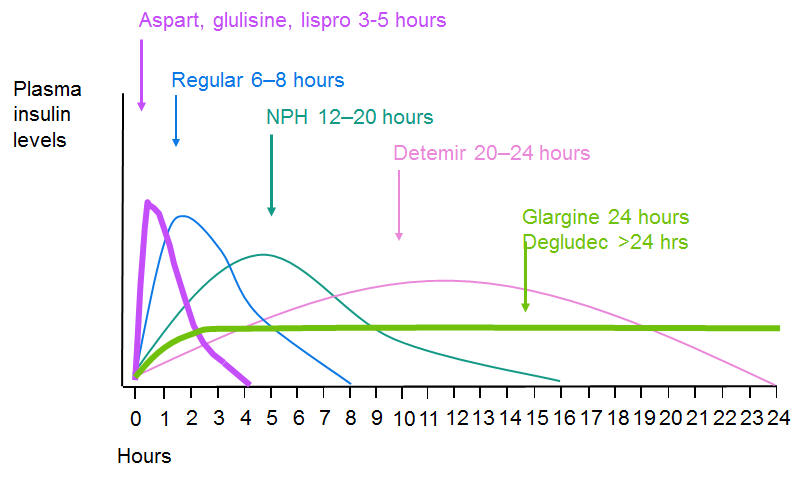|
Types of
insulin available include rapid-acting, short-acting,
intermediate-acting, long-acting, and pre-mixed. This graph
shows the approximate action on insulin levels of several
insulin medications. The bolus, or quick-acting insulin is
given at mealtimes and offsets the effects of dietary
carbohydrates. The basal or longer-acting insulins offset
hepatic glucose secretion, meeting the body’s basic
metabolic energy needs. Rapid-acting works has an onset of
10-30 minutes and peaks between 30-90 minutes. Variations
are seen in duration from 1-2.5 or 3-5 hours. Short-acting,
shown here as “regular”, have and onset of ˝ to 1 hour, a
peak of between 2-5 hours, and varied durations from 2-3
hours or 5-8 hours. Intermediate-acting insulin, such as NPH
or Lente, have onsets between 1-2.5 hours, a peak between
3-12 hours, and a duration of 18-24 hours. Long-acting
includes ultralente, lantus, and levemir or detemir. The
onset ranges from ˝ to 2 hours, peak levels are varied from
6-8 hours or 10-20 hours, except for lantus, which is
delivered at a steady level. The duration ranges from 20-36
hours. This type of insulin is often combined with rapid or
short-acting insulin therapy. Pre-mixed include products
such as humulin, novolin, novolog, and humalog. These mixes
have both a quick onset and a long duration.
It is important to understand the complementary action of
basal and bolus insulin.
Basal or long-acting insulin:
Offsets
hepatic glucose secretion,
Meets
the body’s basic metabolic energy needs, and
Necessary levels vary; usually providing ~40-50% of daily
insulin total.
Bolus or mealtime rapid-acting insulin:
Offsets
effects of dietary carbohydrates,
Provides
a significant peak action at 1 hour post-meal, and
The use
of Insulin:Carb ratios allows flexible meal planning for
this type of treatment.
|
|
Insulin syringes have varying needle length and are
generally quite thin and virtually painless. Insulin pens
are considered faster and easier than syringes, and are
convenient, provide accurate dosing, and use very thin
disposable needles.
Insulin is delivered subcutaneously using a variety of
injection sites, which may include the abdomen, sides (love
handles), thighs, buttocks, and arms. It is suggested that a
variety of spots should be used at each site. Pinching and
cleansing is not generally necessary. A few seconds should
be allowed for full delivery.
Insulin pumps are external, but connected to an indwelling
subcutaneous catheter to provide rapid-acting insulin at
programmable basal rates. It eliminates extra injections,
has a dose calculator function, and provides a bolus
history. Pumps require the support of qualified
professionals.
There are also injection ports that can allow a single
injection site to be used for several days before
replacement. |
 Instructions
Instructions



